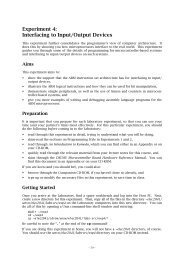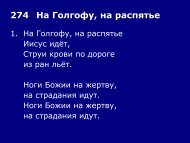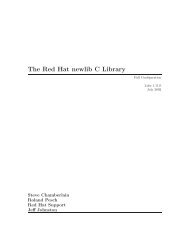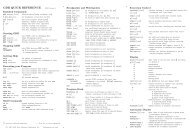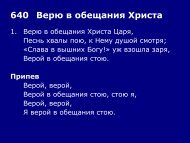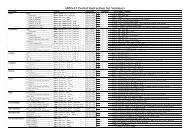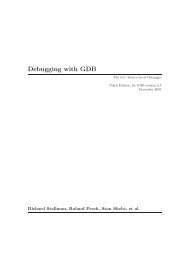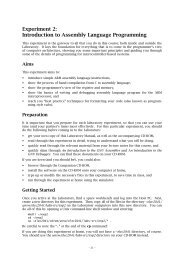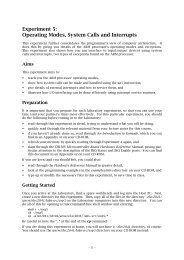The ARM-THUMB Procedure Call Standard
The ARM-THUMB Procedure Call Standard
The ARM-THUMB Procedure Call Standard
Create successful ePaper yourself
Turn your PDF publications into a flip-book with our unique Google optimized e-Paper software.
<strong>The</strong> <strong>ARM</strong>-<strong>THUMB</strong> <strong>Procedure</strong> <strong>Call</strong> <strong>Standard</strong>4 THE BASE STANDARDThis base standard defines a machine-level, integer-only calling standard common to <strong>ARM</strong> and Thumb and amachine-level floating-point standard for <strong>ARM</strong>. <strong>The</strong> Thumb instruction set does not include coprocessorinstructions, there is no machine-level floating-point standard for Thumb.4.1 Machine registers<strong>The</strong>re are 16, 32-bit integer registers visible to the <strong>ARM</strong> and Thumb instruction sets. <strong>The</strong>se are labeled r0-r15 orR0-R15. This specification uses the lower case name when there is no special role for the register.Register Synonym Special Role in the procedure call standardr15 PC <strong>The</strong> Program Counter.r14 LR <strong>The</strong> Link Register.r13 SP <strong>The</strong> Stack Pointer.r12 IP <strong>The</strong> Intra-<strong>Procedure</strong>-call scratch register.r11 v8 FP <strong>ARM</strong>-state variable-register 8. <strong>ARM</strong>-state frame pointer.r10 v7 SL <strong>ARM</strong>-state variable-register 7. Stack Limit pointer in stack-checked variants.r9 v6 SB <strong>ARM</strong>-state v-register 6. Static Base in PID,/re-entrant/shared-library variantsr8 v5 <strong>ARM</strong>-state variable-register 5.r7 v4 WR Variable register (v-register) 4. Thumb-state Work Register.r6 v3 Variable register (v-register) 3.r5 v2 Variable register (v-register) 2.r4 v1 Variable register (v-register) 1.r3 a4 Argument/result/scratch register 4.r2 a3 Argument/result/ scratch register 3.r1 a2 Argument/result/ scratch register 2.r0 a1 Argument/result/ scratch register 1.<strong>The</strong> first four registers r0-r3 are used to pass parameter values into a routine and result values out of a routineand to hold intermediate values within a routine (but, in general, only between subroutine calls). In <strong>ARM</strong>-state,register r12— also called IP— can also be used to hold intermediate values between subroutine calls.Typically, the registers from r4 to r11 are used to hold the values of a routine’s local variables. <strong>The</strong>y are alsolabeled v1-v8. Only v1-v4 can be used uniformly by the whole Thumb instruction set (shown emboldened).In all variants of the procedure call standard, registers r12-r15 have special roles. In these roles they are labeledIP, SP, LR and PC (or ip, sp, lr, and pc, but this standard uses the upper case name for the special role).SWS ESPC 0002 A-05 Page 10 of 37



